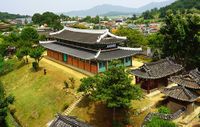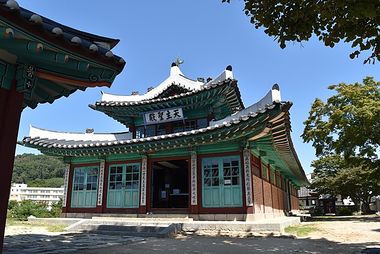대한성공회 강화성당
| 대한성공회 강화성당 (大韓聖公會 江華聖堂) | |
|---|---|
| [[파일:|380px]] | |
| 지정 번호 | 시도유형문화재 제31호 |
| 지정일 | 2001년 1월 4일 |
| 지정 명칭 | 성공회강화성당 |
| 한자 명칭 | 聖公會江華聖堂 |
| 영문 명칭 | Anglican Church of Korea, Gangwha Cathedral |
| 분류 | 유적건조물 / 종교신앙 / 천주교 / 성당 |
| 건립·제작 | 1900년 11월 15일 |
| 주소 | 인천광역시 강화군 강화읍 관청길 22 (관청리 336) |
| 위도 | 37° 44′ 56″ N |
| 경도 | 126° 29′ 16″ E |
| 웹사이트 | |
목차
개관 Overview
인천광역시 강화군 강화읍 관청길에 있는 대한제국시대에 세워진 성공회 성당
Gangwha Cathedral of the Anglican Church of Korea, established during the Joseon Empire, located on Gwancheong road in Gangwha county of Incheon city.
이 페이지는 대한성공회의 강화성당의 역사, 건축 및 종교문화 자산에 중점을 둔다. 한국 건축과 성공회의 전통은 아름답게 디자인 된 한옥(韓屋) 양식의 성당에서 함께 어우러진다. 강화성당은 강화도의 산비탈에 자리 잡고 있는 성당이다. 강화도는 서울의 동쪽에 있는 인천광역시 동쪽에 있는 인천국제공항 동쪽에 있는 도규모 섬이다. 강화도는 한국의 '관문'이기 때문에 역사가 풍부한 과거이다. 19세기 끝으로 오래된 보호되었고 국경을 페쇄시켰던 'Hermit Nation'인 한국은 국경을 개방하였다.
1900년에 한국 성공회 책임을 맡은 찰스 존 코프(Charles John Corfe, 한국명: 고요한) 주교로 강화성당을 설립하였다. 강화성당은 두 문화가 조화를 이루면 얼마나 아름다움을 보여주는 예이다. 코프 주교는 1889년에 조선 최초의 주교로서 한국에 왔으며, 1900년까지 경기도와 충청도뿐만 아니라 인천, 서울에 몇 성당을 세웠다. 초기 영국 성공회 선교사들이 한국학 및 한국 문화와 영어 문화의 통합에서 큰 진보를 이루었다. 코프 주교는 1896년에 강화도에 있는 성공회에 침례를 받은 신자들을 기념하여 강화성당을 세웠다[1].

강화성당: 현재 남아있는 건물로는 제일 오래된 성당으로서 지방문화재로 지정되어 있다.
Gangwha Cathedral: As the oldest standing cathedral in Korea today, the Gangwha Cathedral was designated as a cultural heritage site.
This page focuses on the history, architecture, and religio-cultural assets of Gangwha Cathedral of the Anglican Church of Korea. Korean architecture and Anglican tradition blend together in this beautifully designed Hanok(韓屋) style church. The Gangwha Cathedral sits perched in the hills of Gangwha island. Gangwha Island is a large island located to the east of Incheon International Airport and is a part of Incheon city, which is located just east of Seoul. Gangwha has a rich historic past as it is the 'gateway' into Korea. Towards the end of the 19th century, Korea opened its borders after a lengthy time of being a closed and protected 'Hermit Nation'.
Established in 1900 by Bishop Charles John Corfe(Korean name: Go Yohan(고요한)), Gangwha Cathedral is an example of how beautiful it can be when two cultures harmonize. Bishop Corfe first came to Korea in 1889 as the first diocesan bishop of Joseon and, by 1900, had already established a few Anglican churches in Incheon, Seoul, as well as in Gyeonggi and Chungcheong provinces. The early Anglican missionaries made large strides in Korean studies and integrating Korean and English cultures.
Bishop Corfe established Gangwha Cathedral in memorial of those who were baptized into the Anglican Church on Gangwha Island in 1896.
역사 History
성공회 The Anglican Church[2]
The name "Anglican" means "of England", but the Anglican church exists worldwide. It began in the sixth century in England, when Pope Gregory the Great sent St. Augustine to Britain to bring a more disciplined Apostolic succession to the Celtic Christians. The Anglican Church evolved as part of the Roman church, but the Celtic influence was folded back into the Roman portion of the church in many ways, perhaps most notably by Charlemagne's tutor Aidan. The Anglican church was spread worldwide first by English colonization and then by English-speaking missionaries.
The Anglican church, although it has apostolic succession, is separate from the Roman church. The history of Christianity has produced numerous notable separations. In 1054 came the first major split from Roman administration of the church, when the Eastern Orthodox church and the Roman split apart.
The conflict of authority in England between church and state certainly dates back to the arrival of Augustine, and has simmered for many centuries. The murder of Thomas a Becket was one of the more famous episodes of this conflict. The Magna Carta, signed by King John in 1215, contains 63 points; the very first point is a declaration that the English church is independent of its government..
Discontent with Roman administration of the church.
The beginning of the sixteenth century showed significant discontent with the Roman church. Martin Luther's famous 95 Theses were nailed to the door of the church in Wittenburg in 1517, and news of this challenge had certainly reached England when, 20 years later, the Anglican branch of the church formally challenged the authority of Rome. Henry VIII dissolved the monasteries and abbeys in 1536.
There is a public perception, especially in the United States, that Henry VIII created the Anglican church in anger over the Pope's refusal to grant his divorce, but the historical record indicates that Henry spent most of his reign challenging the authority of Rome, and that the divorce issue was just one of a series of acts that collectively split the English church from the Roman church in much the same way that the Orthodox church had split off five hundred years before.
Defining the new church
The newly-separated Anglican church was given some formal structure in 1562 during the reign of Elizabeth I. That structure is not a management process or governing organization. What binds us together is not common administration but shared tradition and shared belief. Our belief is written down in the Holy Bible and the Articles of Religion; our tradition is in part embodied in our Book of Common Prayer. The first Book of Common Prayer was produced in 1549. In it the Latin liturgy was radically simplified and translated into English, and for the first time a single 'use' was enforced throughout England. It has been revised numerous times since then, the most significant revision being the first, in 1552. All revisions since then, before the modern era, were very conservative revisions. The 1662 English Book of Common Prayer forms the historical basis for most Anglican liturgy around the world. While several countries have their own prayer books, all borrow heavily from the English tradition rooted in Cranmer's original work.
Further Information
Church history has been an important part of the cultural history of every nation, and through the centuries thousands of books have been written about it. Every library and every encyclopedia will cover it to some degree. An informative online starting point for learning more about the history of the Anglican Church is The Anglican Timeline, produced by the American physician Ed Friedlander, MD. It lists several hundred notable events in the history of the Anglican church, with large numbers of links to reference materials and primary sources.
대한성공회 The Anglican Church of Korea
강화도, 선교사와 한국민족 Gangwhado, The Missionaries and the Korean People
건축 Architecture
한옥 Hanok
성당과 교회 차이가 무엇인가? What is the difference between a cathedral and a church?
바실리카 Basilica
조화 이님 혼합? Harmonization or Syncretism?
종교문화 Religion and Culture
영국 국교회주의 Anglicanism
1900년대 대한제국의 종교지리 The Religious Geography of the Joseon Empire in 1900
위치 Location
출처
- ↑ 대한성공회 백년사
- ↑ http://anglican.org/church/ChurchHistory.html
기여 Contributors
| 역할 | 이름 | 전공 |
| 편집 및 정리 | 로버트 에릭 라이언버거 | 인문정보학 |
